Report: Introduction to Effective Caring, Quality of Life
VerifiedAdded on 2022/12/26
|10
|3214
|96
Report
AI Summary
This report provides a detailed analysis of effective caring, exploring various factors that contribute to a good quality of life, including physical, emotional, social, and intellectual aspects. It outlines key caring techniques such as observation, social perception, communication, building trust, and safe working practices, emphasizing their importance in enhancing an individual's well-being. The report also identifies barriers to positive caring, offering a comprehensive understanding of the challenges faced in providing effective care. The content covers a range of topics from physical environment and proper diet to social contact and support, intellectual life, and adaptive behaviors. Overall, this report aims to provide insights into the multifaceted nature of effective caring and its impact on improving the lives of individuals. This report is designed to assist students in healthcare and research by providing a comprehensive overview of effective caring and its various dimensions.
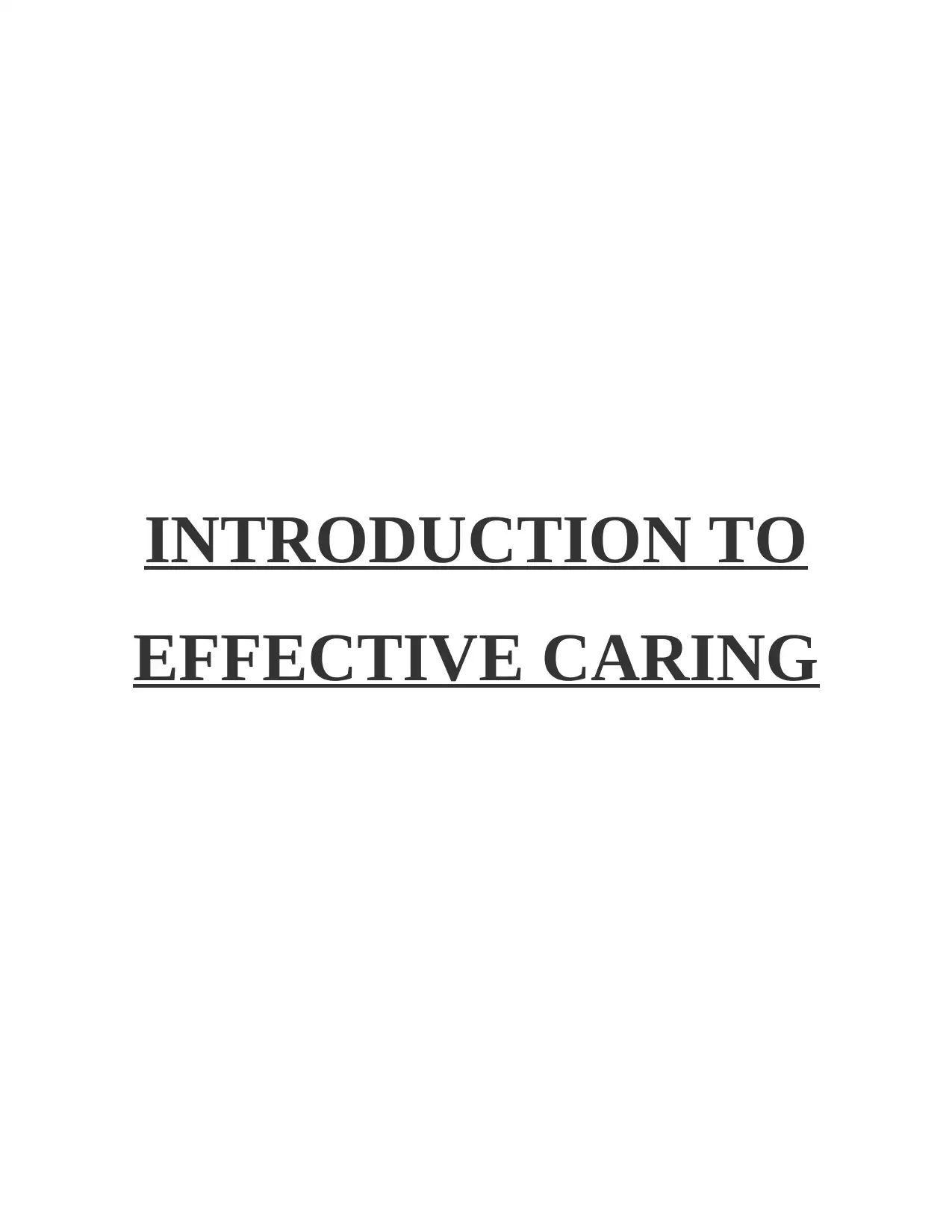
INTRODUCTION TO
EFFECTIVE CARING
EFFECTIVE CARING
Paraphrase This Document
Need a fresh take? Get an instant paraphrase of this document with our AI Paraphraser
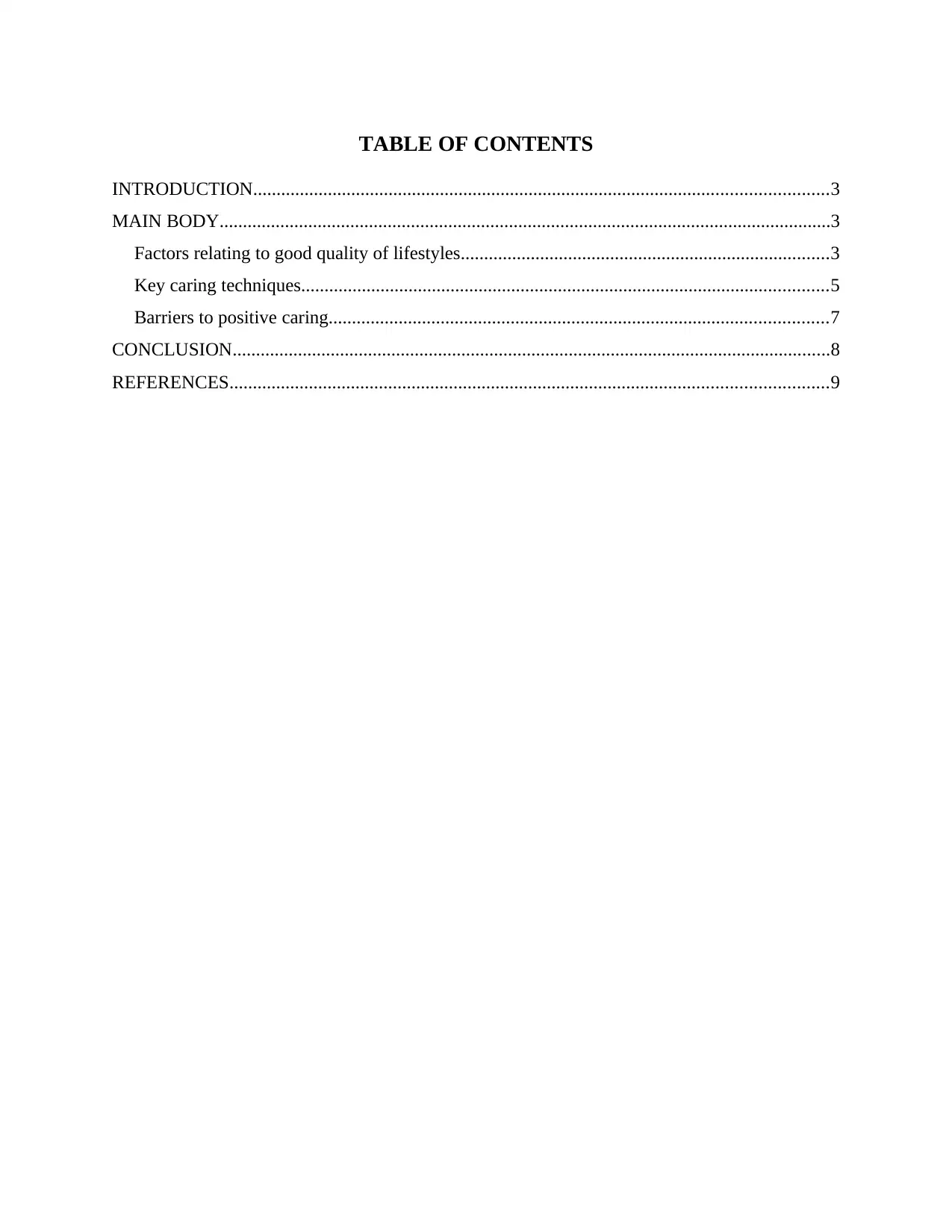
TABLE OF CONTENTS
INTRODUCTION...........................................................................................................................3
MAIN BODY...................................................................................................................................3
Factors relating to good quality of lifestyles...............................................................................3
Key caring techniques.................................................................................................................5
Barriers to positive caring...........................................................................................................7
CONCLUSION................................................................................................................................8
REFERENCES................................................................................................................................9
INTRODUCTION...........................................................................................................................3
MAIN BODY...................................................................................................................................3
Factors relating to good quality of lifestyles...............................................................................3
Key caring techniques.................................................................................................................5
Barriers to positive caring...........................................................................................................7
CONCLUSION................................................................................................................................8
REFERENCES................................................................................................................................9
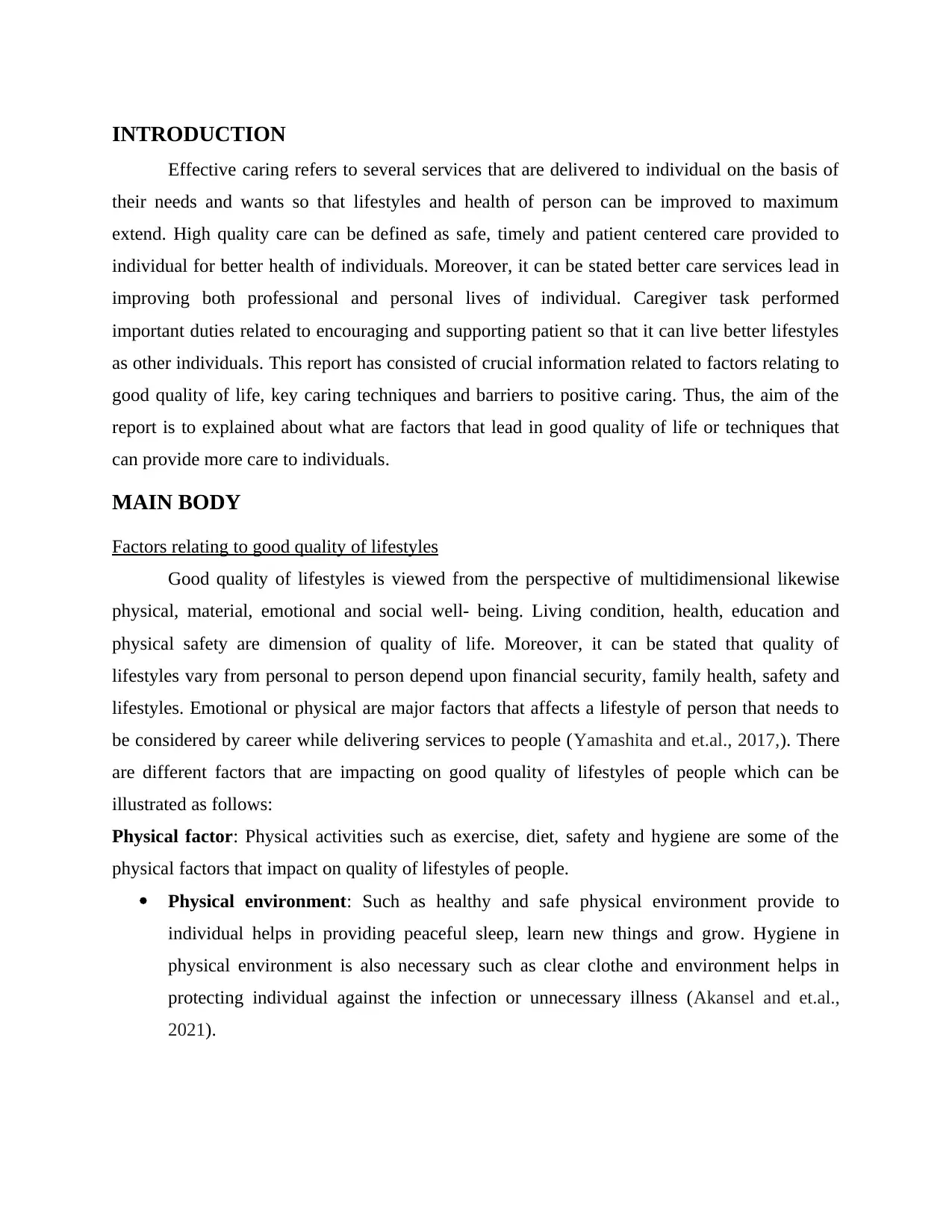
INTRODUCTION
Effective caring refers to several services that are delivered to individual on the basis of
their needs and wants so that lifestyles and health of person can be improved to maximum
extend. High quality care can be defined as safe, timely and patient centered care provided to
individual for better health of individuals. Moreover, it can be stated better care services lead in
improving both professional and personal lives of individual. Caregiver task performed
important duties related to encouraging and supporting patient so that it can live better lifestyles
as other individuals. This report has consisted of crucial information related to factors relating to
good quality of life, key caring techniques and barriers to positive caring. Thus, the aim of the
report is to explained about what are factors that lead in good quality of life or techniques that
can provide more care to individuals.
MAIN BODY
Factors relating to good quality of lifestyles
Good quality of lifestyles is viewed from the perspective of multidimensional likewise
physical, material, emotional and social well- being. Living condition, health, education and
physical safety are dimension of quality of life. Moreover, it can be stated that quality of
lifestyles vary from personal to person depend upon financial security, family health, safety and
lifestyles. Emotional or physical are major factors that affects a lifestyle of person that needs to
be considered by career while delivering services to people (Yamashita and et.al., 2017,). There
are different factors that are impacting on good quality of lifestyles of people which can be
illustrated as follows:
Physical factor: Physical activities such as exercise, diet, safety and hygiene are some of the
physical factors that impact on quality of lifestyles of people.
Physical environment: Such as healthy and safe physical environment provide to
individual helps in providing peaceful sleep, learn new things and grow. Hygiene in
physical environment is also necessary such as clear clothe and environment helps in
protecting individual against the infection or unnecessary illness (Akansel and et.al.,
2021).
Effective caring refers to several services that are delivered to individual on the basis of
their needs and wants so that lifestyles and health of person can be improved to maximum
extend. High quality care can be defined as safe, timely and patient centered care provided to
individual for better health of individuals. Moreover, it can be stated better care services lead in
improving both professional and personal lives of individual. Caregiver task performed
important duties related to encouraging and supporting patient so that it can live better lifestyles
as other individuals. This report has consisted of crucial information related to factors relating to
good quality of life, key caring techniques and barriers to positive caring. Thus, the aim of the
report is to explained about what are factors that lead in good quality of life or techniques that
can provide more care to individuals.
MAIN BODY
Factors relating to good quality of lifestyles
Good quality of lifestyles is viewed from the perspective of multidimensional likewise
physical, material, emotional and social well- being. Living condition, health, education and
physical safety are dimension of quality of life. Moreover, it can be stated that quality of
lifestyles vary from personal to person depend upon financial security, family health, safety and
lifestyles. Emotional or physical are major factors that affects a lifestyle of person that needs to
be considered by career while delivering services to people (Yamashita and et.al., 2017,). There
are different factors that are impacting on good quality of lifestyles of people which can be
illustrated as follows:
Physical factor: Physical activities such as exercise, diet, safety and hygiene are some of the
physical factors that impact on quality of lifestyles of people.
Physical environment: Such as healthy and safe physical environment provide to
individual helps in providing peaceful sleep, learn new things and grow. Hygiene in
physical environment is also necessary such as clear clothe and environment helps in
protecting individual against the infection or unnecessary illness (Akansel and et.al.,
2021).
⊘ This is a preview!⊘
Do you want full access?
Subscribe today to unlock all pages.

Trusted by 1+ million students worldwide
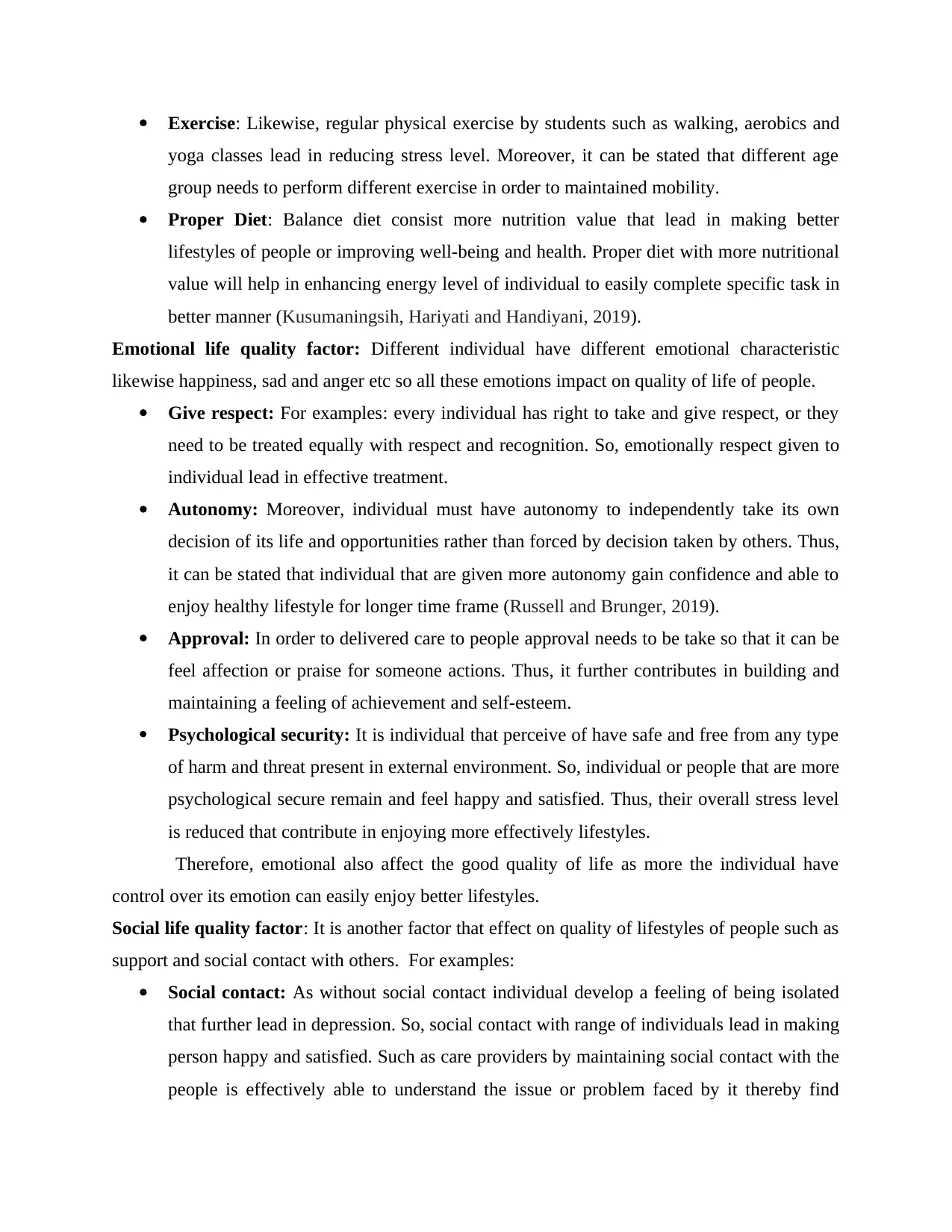
Exercise: Likewise, regular physical exercise by students such as walking, aerobics and
yoga classes lead in reducing stress level. Moreover, it can be stated that different age
group needs to perform different exercise in order to maintained mobility.
Proper Diet: Balance diet consist more nutrition value that lead in making better
lifestyles of people or improving well-being and health. Proper diet with more nutritional
value will help in enhancing energy level of individual to easily complete specific task in
better manner (Kusumaningsih, Hariyati and Handiyani, 2019).
Emotional life quality factor: Different individual have different emotional characteristic
likewise happiness, sad and anger etc so all these emotions impact on quality of life of people.
Give respect: For examples: every individual has right to take and give respect, or they
need to be treated equally with respect and recognition. So, emotionally respect given to
individual lead in effective treatment.
Autonomy: Moreover, individual must have autonomy to independently take its own
decision of its life and opportunities rather than forced by decision taken by others. Thus,
it can be stated that individual that are given more autonomy gain confidence and able to
enjoy healthy lifestyle for longer time frame (Russell and Brunger, 2019).
Approval: In order to delivered care to people approval needs to be take so that it can be
feel affection or praise for someone actions. Thus, it further contributes in building and
maintaining a feeling of achievement and self-esteem.
Psychological security: It is individual that perceive of have safe and free from any type
of harm and threat present in external environment. So, individual or people that are more
psychological secure remain and feel happy and satisfied. Thus, their overall stress level
is reduced that contribute in enjoying more effectively lifestyles.
Therefore, emotional also affect the good quality of life as more the individual have
control over its emotion can easily enjoy better lifestyles.
Social life quality factor: It is another factor that effect on quality of lifestyles of people such as
support and social contact with others. For examples:
Social contact: As without social contact individual develop a feeling of being isolated
that further lead in depression. So, social contact with range of individuals lead in making
person happy and satisfied. Such as care providers by maintaining social contact with the
people is effectively able to understand the issue or problem faced by it thereby find
yoga classes lead in reducing stress level. Moreover, it can be stated that different age
group needs to perform different exercise in order to maintained mobility.
Proper Diet: Balance diet consist more nutrition value that lead in making better
lifestyles of people or improving well-being and health. Proper diet with more nutritional
value will help in enhancing energy level of individual to easily complete specific task in
better manner (Kusumaningsih, Hariyati and Handiyani, 2019).
Emotional life quality factor: Different individual have different emotional characteristic
likewise happiness, sad and anger etc so all these emotions impact on quality of life of people.
Give respect: For examples: every individual has right to take and give respect, or they
need to be treated equally with respect and recognition. So, emotionally respect given to
individual lead in effective treatment.
Autonomy: Moreover, individual must have autonomy to independently take its own
decision of its life and opportunities rather than forced by decision taken by others. Thus,
it can be stated that individual that are given more autonomy gain confidence and able to
enjoy healthy lifestyle for longer time frame (Russell and Brunger, 2019).
Approval: In order to delivered care to people approval needs to be take so that it can be
feel affection or praise for someone actions. Thus, it further contributes in building and
maintaining a feeling of achievement and self-esteem.
Psychological security: It is individual that perceive of have safe and free from any type
of harm and threat present in external environment. So, individual or people that are more
psychological secure remain and feel happy and satisfied. Thus, their overall stress level
is reduced that contribute in enjoying more effectively lifestyles.
Therefore, emotional also affect the good quality of life as more the individual have
control over its emotion can easily enjoy better lifestyles.
Social life quality factor: It is another factor that effect on quality of lifestyles of people such as
support and social contact with others. For examples:
Social contact: As without social contact individual develop a feeling of being isolated
that further lead in depression. So, social contact with range of individuals lead in making
person happy and satisfied. Such as care providers by maintaining social contact with the
people is effectively able to understand the issue or problem faced by it thereby find
Paraphrase This Document
Need a fresh take? Get an instant paraphrase of this document with our AI Paraphraser
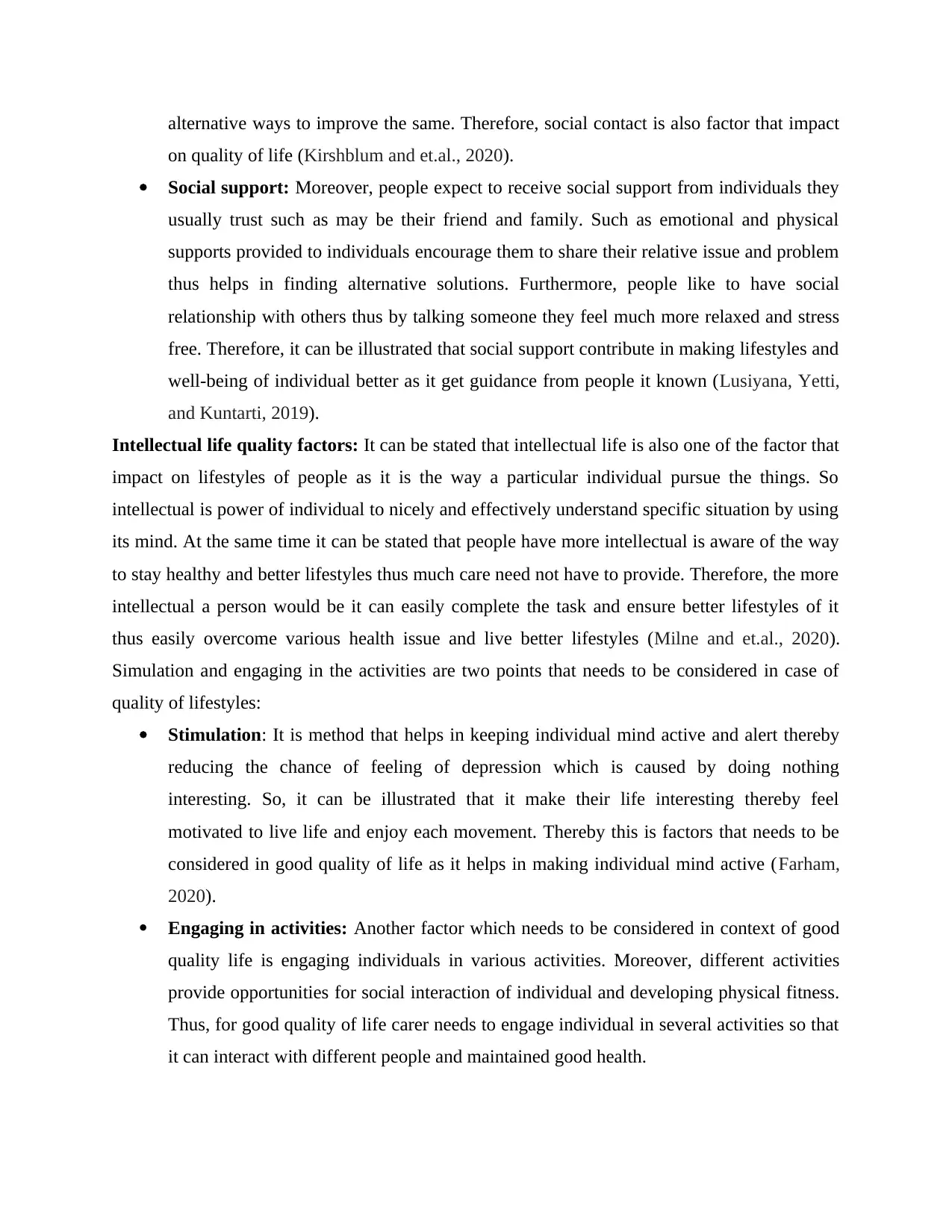
alternative ways to improve the same. Therefore, social contact is also factor that impact
on quality of life (Kirshblum and et.al., 2020).
Social support: Moreover, people expect to receive social support from individuals they
usually trust such as may be their friend and family. Such as emotional and physical
supports provided to individuals encourage them to share their relative issue and problem
thus helps in finding alternative solutions. Furthermore, people like to have social
relationship with others thus by talking someone they feel much more relaxed and stress
free. Therefore, it can be illustrated that social support contribute in making lifestyles and
well-being of individual better as it get guidance from people it known (Lusiyana, Yetti,
and Kuntarti, 2019).
Intellectual life quality factors: It can be stated that intellectual life is also one of the factor that
impact on lifestyles of people as it is the way a particular individual pursue the things. So
intellectual is power of individual to nicely and effectively understand specific situation by using
its mind. At the same time it can be stated that people have more intellectual is aware of the way
to stay healthy and better lifestyles thus much care need not have to provide. Therefore, the more
intellectual a person would be it can easily complete the task and ensure better lifestyles of it
thus easily overcome various health issue and live better lifestyles (Milne and et.al., 2020).
Simulation and engaging in the activities are two points that needs to be considered in case of
quality of lifestyles:
Stimulation: It is method that helps in keeping individual mind active and alert thereby
reducing the chance of feeling of depression which is caused by doing nothing
interesting. So, it can be illustrated that it make their life interesting thereby feel
motivated to live life and enjoy each movement. Thereby this is factors that needs to be
considered in good quality of life as it helps in making individual mind active (Farham,
2020).
Engaging in activities: Another factor which needs to be considered in context of good
quality life is engaging individuals in various activities. Moreover, different activities
provide opportunities for social interaction of individual and developing physical fitness.
Thus, for good quality of life carer needs to engage individual in several activities so that
it can interact with different people and maintained good health.
on quality of life (Kirshblum and et.al., 2020).
Social support: Moreover, people expect to receive social support from individuals they
usually trust such as may be their friend and family. Such as emotional and physical
supports provided to individuals encourage them to share their relative issue and problem
thus helps in finding alternative solutions. Furthermore, people like to have social
relationship with others thus by talking someone they feel much more relaxed and stress
free. Therefore, it can be illustrated that social support contribute in making lifestyles and
well-being of individual better as it get guidance from people it known (Lusiyana, Yetti,
and Kuntarti, 2019).
Intellectual life quality factors: It can be stated that intellectual life is also one of the factor that
impact on lifestyles of people as it is the way a particular individual pursue the things. So
intellectual is power of individual to nicely and effectively understand specific situation by using
its mind. At the same time it can be stated that people have more intellectual is aware of the way
to stay healthy and better lifestyles thus much care need not have to provide. Therefore, the more
intellectual a person would be it can easily complete the task and ensure better lifestyles of it
thus easily overcome various health issue and live better lifestyles (Milne and et.al., 2020).
Simulation and engaging in the activities are two points that needs to be considered in case of
quality of lifestyles:
Stimulation: It is method that helps in keeping individual mind active and alert thereby
reducing the chance of feeling of depression which is caused by doing nothing
interesting. So, it can be illustrated that it make their life interesting thereby feel
motivated to live life and enjoy each movement. Thereby this is factors that needs to be
considered in good quality of life as it helps in making individual mind active (Farham,
2020).
Engaging in activities: Another factor which needs to be considered in context of good
quality life is engaging individuals in various activities. Moreover, different activities
provide opportunities for social interaction of individual and developing physical fitness.
Thus, for good quality of life carer needs to engage individual in several activities so that
it can interact with different people and maintained good health.
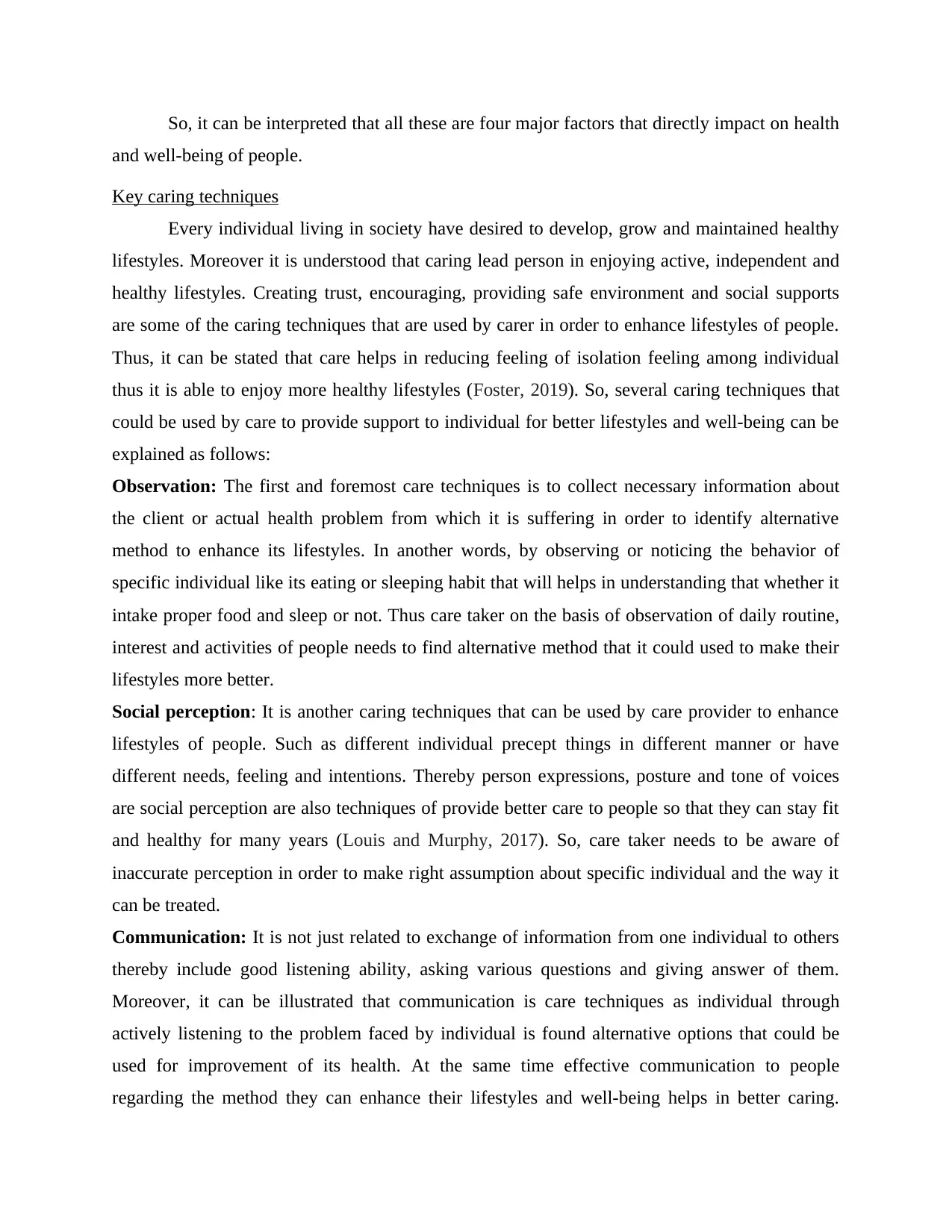
So, it can be interpreted that all these are four major factors that directly impact on health
and well-being of people.
Key caring techniques
Every individual living in society have desired to develop, grow and maintained healthy
lifestyles. Moreover it is understood that caring lead person in enjoying active, independent and
healthy lifestyles. Creating trust, encouraging, providing safe environment and social supports
are some of the caring techniques that are used by carer in order to enhance lifestyles of people.
Thus, it can be stated that care helps in reducing feeling of isolation feeling among individual
thus it is able to enjoy more healthy lifestyles (Foster, 2019). So, several caring techniques that
could be used by care to provide support to individual for better lifestyles and well-being can be
explained as follows:
Observation: The first and foremost care techniques is to collect necessary information about
the client or actual health problem from which it is suffering in order to identify alternative
method to enhance its lifestyles. In another words, by observing or noticing the behavior of
specific individual like its eating or sleeping habit that will helps in understanding that whether it
intake proper food and sleep or not. Thus care taker on the basis of observation of daily routine,
interest and activities of people needs to find alternative method that it could used to make their
lifestyles more better.
Social perception: It is another caring techniques that can be used by care provider to enhance
lifestyles of people. Such as different individual precept things in different manner or have
different needs, feeling and intentions. Thereby person expressions, posture and tone of voices
are social perception are also techniques of provide better care to people so that they can stay fit
and healthy for many years (Louis and Murphy, 2017). So, care taker needs to be aware of
inaccurate perception in order to make right assumption about specific individual and the way it
can be treated.
Communication: It is not just related to exchange of information from one individual to others
thereby include good listening ability, asking various questions and giving answer of them.
Moreover, it can be illustrated that communication is care techniques as individual through
actively listening to the problem faced by individual is found alternative options that could be
used for improvement of its health. At the same time effective communication to people
regarding the method they can enhance their lifestyles and well-being helps in better caring.
and well-being of people.
Key caring techniques
Every individual living in society have desired to develop, grow and maintained healthy
lifestyles. Moreover it is understood that caring lead person in enjoying active, independent and
healthy lifestyles. Creating trust, encouraging, providing safe environment and social supports
are some of the caring techniques that are used by carer in order to enhance lifestyles of people.
Thus, it can be stated that care helps in reducing feeling of isolation feeling among individual
thus it is able to enjoy more healthy lifestyles (Foster, 2019). So, several caring techniques that
could be used by care to provide support to individual for better lifestyles and well-being can be
explained as follows:
Observation: The first and foremost care techniques is to collect necessary information about
the client or actual health problem from which it is suffering in order to identify alternative
method to enhance its lifestyles. In another words, by observing or noticing the behavior of
specific individual like its eating or sleeping habit that will helps in understanding that whether it
intake proper food and sleep or not. Thus care taker on the basis of observation of daily routine,
interest and activities of people needs to find alternative method that it could used to make their
lifestyles more better.
Social perception: It is another caring techniques that can be used by care provider to enhance
lifestyles of people. Such as different individual precept things in different manner or have
different needs, feeling and intentions. Thereby person expressions, posture and tone of voices
are social perception are also techniques of provide better care to people so that they can stay fit
and healthy for many years (Louis and Murphy, 2017). So, care taker needs to be aware of
inaccurate perception in order to make right assumption about specific individual and the way it
can be treated.
Communication: It is not just related to exchange of information from one individual to others
thereby include good listening ability, asking various questions and giving answer of them.
Moreover, it can be illustrated that communication is care techniques as individual through
actively listening to the problem faced by individual is found alternative options that could be
used for improvement of its health. At the same time effective communication to people
regarding the method they can enhance their lifestyles and well-being helps in better caring.
⊘ This is a preview!⊘
Do you want full access?
Subscribe today to unlock all pages.

Trusted by 1+ million students worldwide
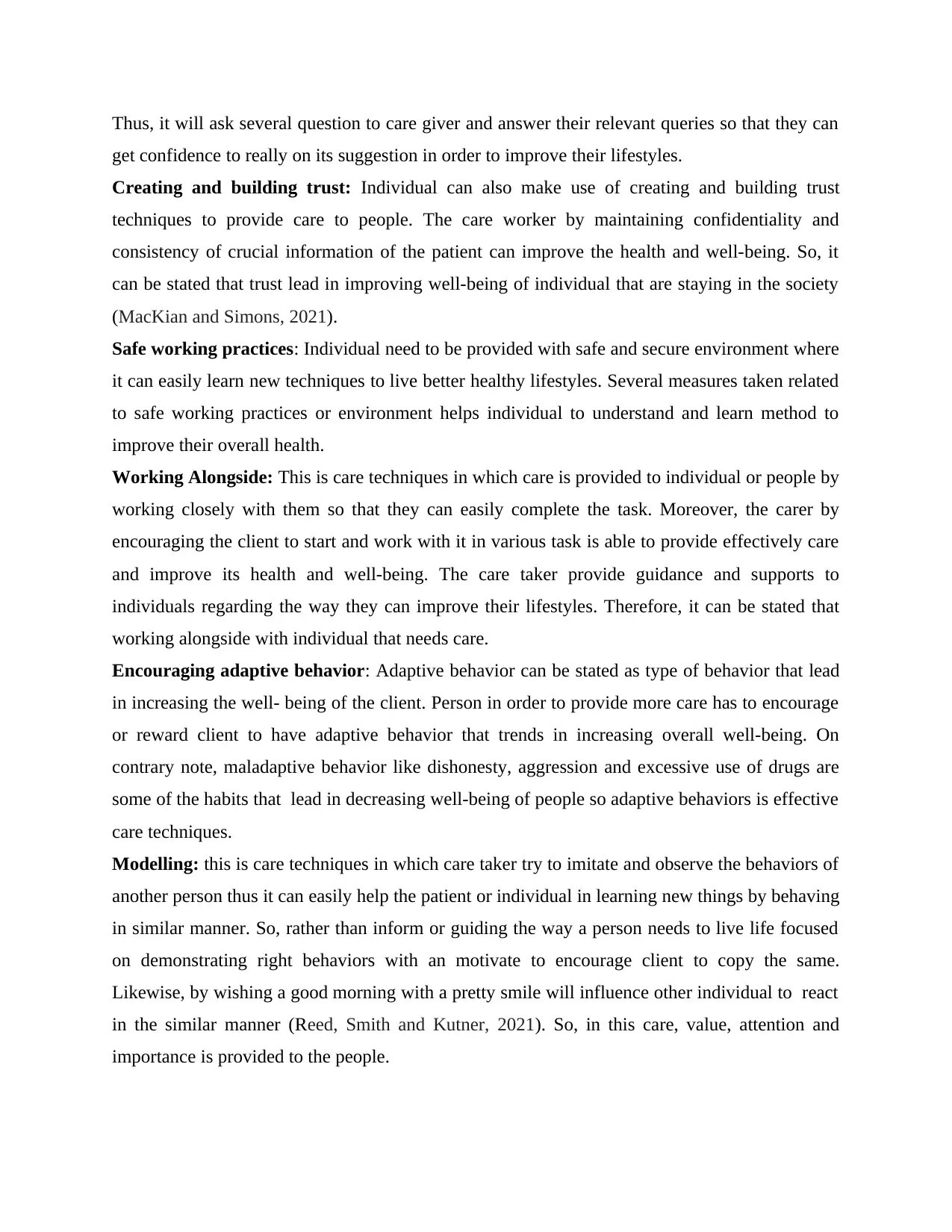
Thus, it will ask several question to care giver and answer their relevant queries so that they can
get confidence to really on its suggestion in order to improve their lifestyles.
Creating and building trust: Individual can also make use of creating and building trust
techniques to provide care to people. The care worker by maintaining confidentiality and
consistency of crucial information of the patient can improve the health and well-being. So, it
can be stated that trust lead in improving well-being of individual that are staying in the society
(MacKian and Simons, 2021).
Safe working practices: Individual need to be provided with safe and secure environment where
it can easily learn new techniques to live better healthy lifestyles. Several measures taken related
to safe working practices or environment helps individual to understand and learn method to
improve their overall health.
Working Alongside: This is care techniques in which care is provided to individual or people by
working closely with them so that they can easily complete the task. Moreover, the carer by
encouraging the client to start and work with it in various task is able to provide effectively care
and improve its health and well-being. The care taker provide guidance and supports to
individuals regarding the way they can improve their lifestyles. Therefore, it can be stated that
working alongside with individual that needs care.
Encouraging adaptive behavior: Adaptive behavior can be stated as type of behavior that lead
in increasing the well- being of the client. Person in order to provide more care has to encourage
or reward client to have adaptive behavior that trends in increasing overall well-being. On
contrary note, maladaptive behavior like dishonesty, aggression and excessive use of drugs are
some of the habits that lead in decreasing well-being of people so adaptive behaviors is effective
care techniques.
Modelling: this is care techniques in which care taker try to imitate and observe the behaviors of
another person thus it can easily help the patient or individual in learning new things by behaving
in similar manner. So, rather than inform or guiding the way a person needs to live life focused
on demonstrating right behaviors with an motivate to encourage client to copy the same.
Likewise, by wishing a good morning with a pretty smile will influence other individual to react
in the similar manner (Reed, Smith and Kutner, 2021). So, in this care, value, attention and
importance is provided to the people.
get confidence to really on its suggestion in order to improve their lifestyles.
Creating and building trust: Individual can also make use of creating and building trust
techniques to provide care to people. The care worker by maintaining confidentiality and
consistency of crucial information of the patient can improve the health and well-being. So, it
can be stated that trust lead in improving well-being of individual that are staying in the society
(MacKian and Simons, 2021).
Safe working practices: Individual need to be provided with safe and secure environment where
it can easily learn new techniques to live better healthy lifestyles. Several measures taken related
to safe working practices or environment helps individual to understand and learn method to
improve their overall health.
Working Alongside: This is care techniques in which care is provided to individual or people by
working closely with them so that they can easily complete the task. Moreover, the carer by
encouraging the client to start and work with it in various task is able to provide effectively care
and improve its health and well-being. The care taker provide guidance and supports to
individuals regarding the way they can improve their lifestyles. Therefore, it can be stated that
working alongside with individual that needs care.
Encouraging adaptive behavior: Adaptive behavior can be stated as type of behavior that lead
in increasing the well- being of the client. Person in order to provide more care has to encourage
or reward client to have adaptive behavior that trends in increasing overall well-being. On
contrary note, maladaptive behavior like dishonesty, aggression and excessive use of drugs are
some of the habits that lead in decreasing well-being of people so adaptive behaviors is effective
care techniques.
Modelling: this is care techniques in which care taker try to imitate and observe the behaviors of
another person thus it can easily help the patient or individual in learning new things by behaving
in similar manner. So, rather than inform or guiding the way a person needs to live life focused
on demonstrating right behaviors with an motivate to encourage client to copy the same.
Likewise, by wishing a good morning with a pretty smile will influence other individual to react
in the similar manner (Reed, Smith and Kutner, 2021). So, in this care, value, attention and
importance is provided to the people.
Paraphrase This Document
Need a fresh take? Get an instant paraphrase of this document with our AI Paraphraser
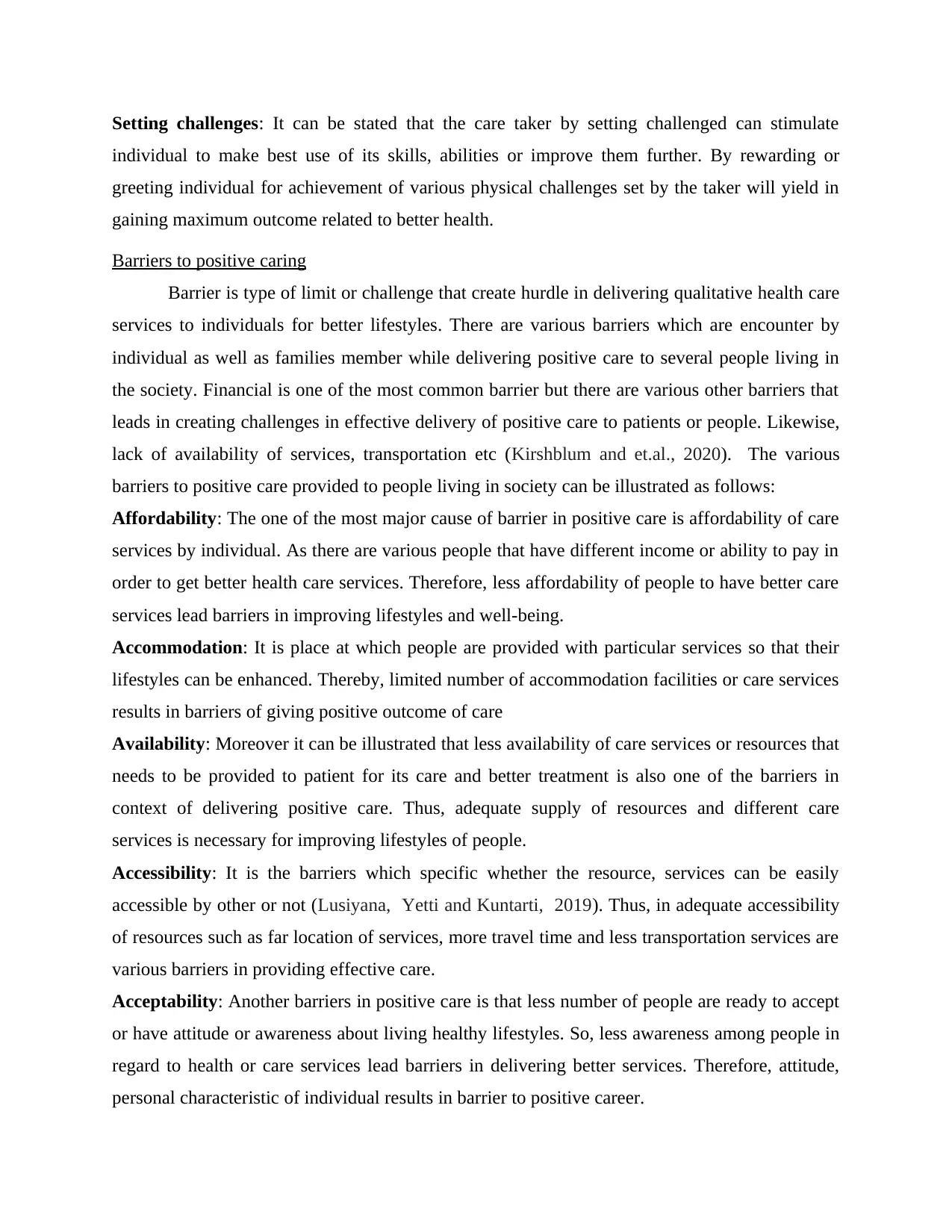
Setting challenges: It can be stated that the care taker by setting challenged can stimulate
individual to make best use of its skills, abilities or improve them further. By rewarding or
greeting individual for achievement of various physical challenges set by the taker will yield in
gaining maximum outcome related to better health.
Barriers to positive caring
Barrier is type of limit or challenge that create hurdle in delivering qualitative health care
services to individuals for better lifestyles. There are various barriers which are encounter by
individual as well as families member while delivering positive care to several people living in
the society. Financial is one of the most common barrier but there are various other barriers that
leads in creating challenges in effective delivery of positive care to patients or people. Likewise,
lack of availability of services, transportation etc (Kirshblum and et.al., 2020). The various
barriers to positive care provided to people living in society can be illustrated as follows:
Affordability: The one of the most major cause of barrier in positive care is affordability of care
services by individual. As there are various people that have different income or ability to pay in
order to get better health care services. Therefore, less affordability of people to have better care
services lead barriers in improving lifestyles and well-being.
Accommodation: It is place at which people are provided with particular services so that their
lifestyles can be enhanced. Thereby, limited number of accommodation facilities or care services
results in barriers of giving positive outcome of care
Availability: Moreover it can be illustrated that less availability of care services or resources that
needs to be provided to patient for its care and better treatment is also one of the barriers in
context of delivering positive care. Thus, adequate supply of resources and different care
services is necessary for improving lifestyles of people.
Accessibility: It is the barriers which specific whether the resource, services can be easily
accessible by other or not (Lusiyana, Yetti and Kuntarti, 2019). Thus, in adequate accessibility
of resources such as far location of services, more travel time and less transportation services are
various barriers in providing effective care.
Acceptability: Another barriers in positive care is that less number of people are ready to accept
or have attitude or awareness about living healthy lifestyles. So, less awareness among people in
regard to health or care services lead barriers in delivering better services. Therefore, attitude,
personal characteristic of individual results in barrier to positive career.
individual to make best use of its skills, abilities or improve them further. By rewarding or
greeting individual for achievement of various physical challenges set by the taker will yield in
gaining maximum outcome related to better health.
Barriers to positive caring
Barrier is type of limit or challenge that create hurdle in delivering qualitative health care
services to individuals for better lifestyles. There are various barriers which are encounter by
individual as well as families member while delivering positive care to several people living in
the society. Financial is one of the most common barrier but there are various other barriers that
leads in creating challenges in effective delivery of positive care to patients or people. Likewise,
lack of availability of services, transportation etc (Kirshblum and et.al., 2020). The various
barriers to positive care provided to people living in society can be illustrated as follows:
Affordability: The one of the most major cause of barrier in positive care is affordability of care
services by individual. As there are various people that have different income or ability to pay in
order to get better health care services. Therefore, less affordability of people to have better care
services lead barriers in improving lifestyles and well-being.
Accommodation: It is place at which people are provided with particular services so that their
lifestyles can be enhanced. Thereby, limited number of accommodation facilities or care services
results in barriers of giving positive outcome of care
Availability: Moreover it can be illustrated that less availability of care services or resources that
needs to be provided to patient for its care and better treatment is also one of the barriers in
context of delivering positive care. Thus, adequate supply of resources and different care
services is necessary for improving lifestyles of people.
Accessibility: It is the barriers which specific whether the resource, services can be easily
accessible by other or not (Lusiyana, Yetti and Kuntarti, 2019). Thus, in adequate accessibility
of resources such as far location of services, more travel time and less transportation services are
various barriers in providing effective care.
Acceptability: Another barriers in positive care is that less number of people are ready to accept
or have attitude or awareness about living healthy lifestyles. So, less awareness among people in
regard to health or care services lead barriers in delivering better services. Therefore, attitude,
personal characteristic of individual results in barrier to positive career.
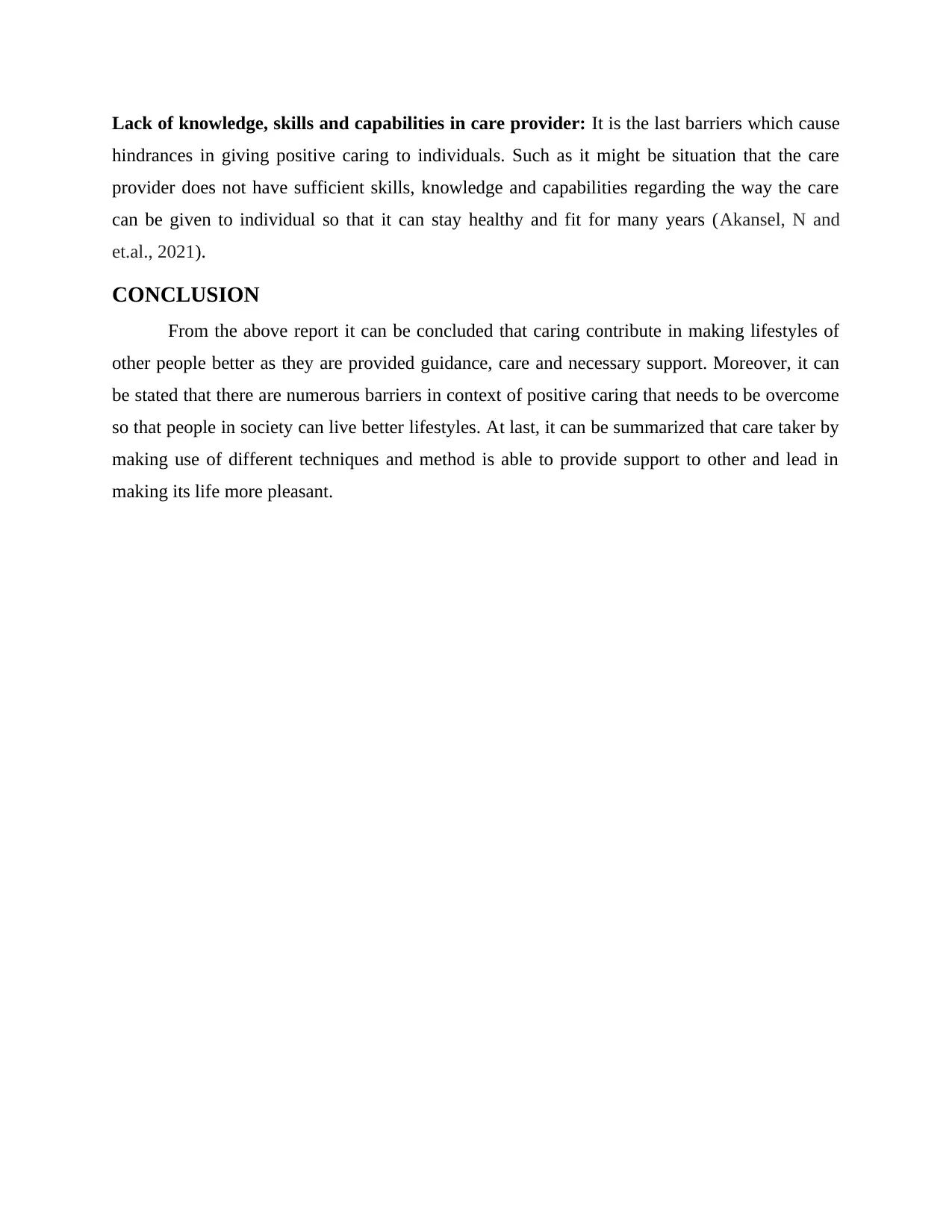
Lack of knowledge, skills and capabilities in care provider: It is the last barriers which cause
hindrances in giving positive caring to individuals. Such as it might be situation that the care
provider does not have sufficient skills, knowledge and capabilities regarding the way the care
can be given to individual so that it can stay healthy and fit for many years (Akansel, N and
et.al., 2021).
CONCLUSION
From the above report it can be concluded that caring contribute in making lifestyles of
other people better as they are provided guidance, care and necessary support. Moreover, it can
be stated that there are numerous barriers in context of positive caring that needs to be overcome
so that people in society can live better lifestyles. At last, it can be summarized that care taker by
making use of different techniques and method is able to provide support to other and lead in
making its life more pleasant.
hindrances in giving positive caring to individuals. Such as it might be situation that the care
provider does not have sufficient skills, knowledge and capabilities regarding the way the care
can be given to individual so that it can stay healthy and fit for many years (Akansel, N and
et.al., 2021).
CONCLUSION
From the above report it can be concluded that caring contribute in making lifestyles of
other people better as they are provided guidance, care and necessary support. Moreover, it can
be stated that there are numerous barriers in context of positive caring that needs to be overcome
so that people in society can live better lifestyles. At last, it can be summarized that care taker by
making use of different techniques and method is able to provide support to other and lead in
making its life more pleasant.
⊘ This is a preview!⊘
Do you want full access?
Subscribe today to unlock all pages.

Trusted by 1+ million students worldwide
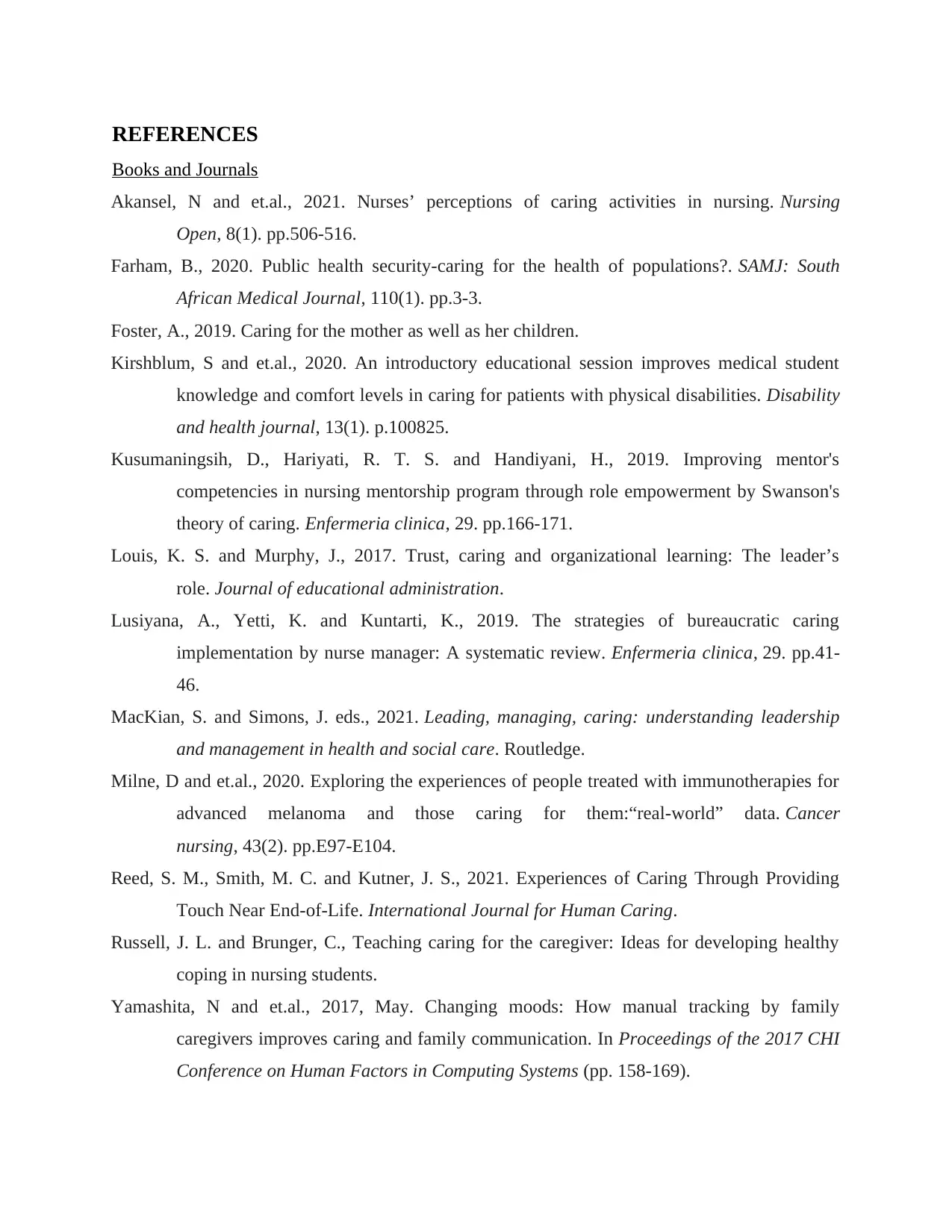
REFERENCES
Books and Journals
Akansel, N and et.al., 2021. Nurses’ perceptions of caring activities in nursing. Nursing
Open, 8(1). pp.506-516.
Farham, B., 2020. Public health security-caring for the health of populations?. SAMJ: South
African Medical Journal, 110(1). pp.3-3.
Foster, A., 2019. Caring for the mother as well as her children.
Kirshblum, S and et.al., 2020. An introductory educational session improves medical student
knowledge and comfort levels in caring for patients with physical disabilities. Disability
and health journal, 13(1). p.100825.
Kusumaningsih, D., Hariyati, R. T. S. and Handiyani, H., 2019. Improving mentor's
competencies in nursing mentorship program through role empowerment by Swanson's
theory of caring. Enfermeria clinica, 29. pp.166-171.
Louis, K. S. and Murphy, J., 2017. Trust, caring and organizational learning: The leader’s
role. Journal of educational administration.
Lusiyana, A., Yetti, K. and Kuntarti, K., 2019. The strategies of bureaucratic caring
implementation by nurse manager: A systematic review. Enfermeria clinica, 29. pp.41-
46.
MacKian, S. and Simons, J. eds., 2021. Leading, managing, caring: understanding leadership
and management in health and social care. Routledge.
Milne, D and et.al., 2020. Exploring the experiences of people treated with immunotherapies for
advanced melanoma and those caring for them:“real-world” data. Cancer
nursing, 43(2). pp.E97-E104.
Reed, S. M., Smith, M. C. and Kutner, J. S., 2021. Experiences of Caring Through Providing
Touch Near End-of-Life. International Journal for Human Caring.
Russell, J. L. and Brunger, C., Teaching caring for the caregiver: Ideas for developing healthy
coping in nursing students.
Yamashita, N and et.al., 2017, May. Changing moods: How manual tracking by family
caregivers improves caring and family communication. In Proceedings of the 2017 CHI
Conference on Human Factors in Computing Systems (pp. 158-169).
Books and Journals
Akansel, N and et.al., 2021. Nurses’ perceptions of caring activities in nursing. Nursing
Open, 8(1). pp.506-516.
Farham, B., 2020. Public health security-caring for the health of populations?. SAMJ: South
African Medical Journal, 110(1). pp.3-3.
Foster, A., 2019. Caring for the mother as well as her children.
Kirshblum, S and et.al., 2020. An introductory educational session improves medical student
knowledge and comfort levels in caring for patients with physical disabilities. Disability
and health journal, 13(1). p.100825.
Kusumaningsih, D., Hariyati, R. T. S. and Handiyani, H., 2019. Improving mentor's
competencies in nursing mentorship program through role empowerment by Swanson's
theory of caring. Enfermeria clinica, 29. pp.166-171.
Louis, K. S. and Murphy, J., 2017. Trust, caring and organizational learning: The leader’s
role. Journal of educational administration.
Lusiyana, A., Yetti, K. and Kuntarti, K., 2019. The strategies of bureaucratic caring
implementation by nurse manager: A systematic review. Enfermeria clinica, 29. pp.41-
46.
MacKian, S. and Simons, J. eds., 2021. Leading, managing, caring: understanding leadership
and management in health and social care. Routledge.
Milne, D and et.al., 2020. Exploring the experiences of people treated with immunotherapies for
advanced melanoma and those caring for them:“real-world” data. Cancer
nursing, 43(2). pp.E97-E104.
Reed, S. M., Smith, M. C. and Kutner, J. S., 2021. Experiences of Caring Through Providing
Touch Near End-of-Life. International Journal for Human Caring.
Russell, J. L. and Brunger, C., Teaching caring for the caregiver: Ideas for developing healthy
coping in nursing students.
Yamashita, N and et.al., 2017, May. Changing moods: How manual tracking by family
caregivers improves caring and family communication. In Proceedings of the 2017 CHI
Conference on Human Factors in Computing Systems (pp. 158-169).
1 out of 10
Related Documents
Your All-in-One AI-Powered Toolkit for Academic Success.
+13062052269
info@desklib.com
Available 24*7 on WhatsApp / Email
![[object Object]](/_next/static/media/star-bottom.7253800d.svg)
Unlock your academic potential
Copyright © 2020–2025 A2Z Services. All Rights Reserved. Developed and managed by ZUCOL.





